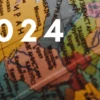What does the EU’s strategy for sustainable and circular textiles mean for fashion and lifestyle brands?
The European Green Deal is one of the most wide-ranging EU political programmes in recent years, and it has significant implications for fashion and lifestyle brands. Consisting of an evolving set of policy proposals, first put forward by the European Commission in 2019, it focuses on driving sustainability and circularity across industries. So, what does it mean for fashion and lifestyle brands operating in the EU and beyond?
What is the EU’s strategy for sustainable and circular textiles?
The textile industry is coming under increasing scrutiny for its social and environmental impacts. In the EU, textile consumption is now on average the fourth largest contributor to environmental and climate change impacts – and the third largest contributor to water and land use impacts from a global life-cycle perspective.[1]
Currently, about 12 kg of textile waste is generated per person per year and only 22% of textile waste is collected for reuse or recycling.[2]
To address these issues, the European Union has proposed its Strategy for sustainable and circular textiles. This aims to ‘help the EU shift to a climate-neutral, circular economy where products are designed to be more durable, reusable, repairable, recyclable and energy-efficient’.[3] The key principles are:
a. Extending the life of textile products
b. Introducing mandatory eco-design requirements
c. Stopping the destruction of unsold or returned textiles
d. Harmonising EU rules for extended producer responsibility for textiles
e. Encouraging reuse and recycling
[1] EU strategy for sustainable textiles (2022) European Commission. Available at: https://ec.europa.eu/info/law/better-regulation/have-your-say/initiatives/12822-EU-strategy-for-sustainable-textiles_en
[2] Waste framework directive: Council set to start talks on its revision (2024) Council of the EU. Available at https://www.consilium.europa.eu/en/press/press-releases/2024/06/17/waste-framework-directive-council-set-to-start-talks-on-its-revision/
[3] EU strategy for sustainable textiles (2022) European Commission. Available at: https://ec.europa.eu/info/law/better-regulation/have-your-say/initiatives/12822-EU-strategy-for-sustainable-textiles_en
How does the EU pass laws?
The European Commission (EC) can put forward such initiatives through regulations,[1] directives[2]or decisions if applicable to a specific authority or individual. The proposal can either be accepted as is by the European Parliament or discussed further. If Member States don’t comply with official regulations, the EC can launch a formal procedure and have the case referred to the EU Court of Justice. In around 95% of infringement cases, Member States comply with their obligations under EU law before they are referred to the Court. [3] Continued non-compliance can result in the imposition of financial penalties.
[1] Regulations are directly binding throughout the EU as of the date set down in the Official Journal. The most relevant regulation for companies involved in textiles are the Ecodesign for Sustainable Products Regulation (ESPR), the Regulation on Waste Shipments, and the Textile Labeling Regulation.
[2] Directives lay down results to be achieved in every member state, but leave it up to national governments to decide how to adapt their laws to achieve these goals. Each directive specifies the date by which the national laws must be adapted. For textile, fashion and logistics companies, the most significant directives are the Corporate Sustainability Reporting Directive (CSRD), the Waste Framework Directive, and the Unfair Commercial Practices Directive (UCPD).
[3] Commission enforcement of EU law in 2023… (2024) European Commission. Available at: https://ec.europa.eu/commission/presscorner/detail/ov/ip_24_3923
How does the EU’s textiles strategy affect companies?
The EU’s strategy for sustainable and circular textiles includes a collection of regulations and directives that will have a significant impact on companies in the textile industry. Indeed, the EU has already set some targets for member states to reach by 2025. For example, Extended Producer Responsibility (EPR) for textiles – which is already in force in the Netherlands – requires that 50% of garments on sale be ‘prepared for reuse or recycled’ by 2025.[1] EPR is expected to be extended EU-wide in the coming years if the proposed amendments to the Waste Framework Directive are adopted.[2]
Meanwhile, the Ecodesign for Sustainable Products Regulation (ESPR) – which came into force on 18 July 2024 – sets out a number of measures designed to make clothing and other products more robust and easier to recycle. It will also require products to carry a Digital Product Passport (DPP), making it easier to access sustainability and repairability information. Finally, the ESPR introduces a ban on the destruction of unsold textiles and footwear. For many brands, these regulations will require a radical rethink of their sourcing, manufacturing and end-of-life processes. So, how are countries preparing?
[1] A zero waste vision for textiles – Chapter 2: Circular and toxic-free material flows (2024) Zero Waste Europe. Available at: https://zerowasteeurope.eu/library/a-zero-waste-vision-for-textiles-circular-and-toxic-free-material-flows/
[2] (2024) Waste framework directive: Council set to START talks on its revision. Available at: https://www.consilium.europa.eu/en/press/press-releases/2024/06/17/waste-framework-directive-council-set-to-start-talks-on-its-revision
Responses to the EU strategy for sustainable and circular textiles
Since Member States are responsible for the implementation of EU directives, it makes sense for stakeholders to align their implementation approaches at a national level. In Belgium, for example, CircleTex is a cross-sector not-for-profit initiative that aims to set up a national collection system to facilitate textile circularity. [1] Major brands such as JBC have already signed up, paving the way for wider adoption.[2]
Meanwhile, the EPR landscape is even more advanced in France. There, accredited ‘producer responsibility organisations’ (PROs) such as ReFashion have been set up to help producers take responsibility for the end-of-life stage of their products.[3]
These industry-wide approaches are a good way to prepare for compliance with upcoming legislation, and brands should learn about the relevant schemes in key markets.
[1] National circular collection system for textiles - Creamoda Available at https://vlaanderen-circulair.be/en/cases/detail/circletex
[2] Lijbaart, S. (2023) JBC als Eerste Grote moderetailer lid van Circletex, FashionUnited. Available at: https://fashionunited.be/nieuws/mode/jbc-als-eerste-grote-moderetailer-lid-van-circletex/2023062338913
[3] About refashion Available at: https://refashion.fr/pro/en/ab...
Preparing for the future of textile circularity in the EU
While the regulations we’ve discussed have already had far-reaching impacts, the next few years will see even more circularity legislation in the textile industry. Bleckmann is committed to helping the brands we work with prepare for these changes. Check back regularly in the coming months for more articles discussing the impact of EU legislation on fashion and textile brands and how you can ensure your strategy is future-proof.
Want to learn more about how the latest EU regulations will affect your business? Get in contact today for a free consultation with a Bleckmann expert!















